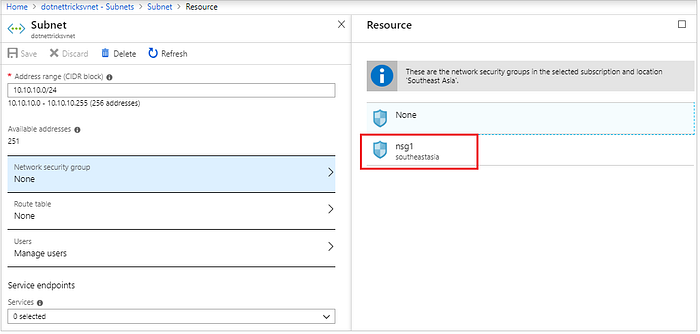Unleashing the Cloud: A Guide to Crafting a Virtual Network in Azure with Terraform

Introduction :-
Embarking on the #cloud journey is a thrilling yet intricate experience. In the realm of #Azure, the prowess of #Terraform becomes a beacon, guiding developers to seamlessly weave a #virtual network that aligns with their architectural vision. This guide is your compass, navigating through the steps of creating a #robust #virtual network, unlocking the true potential of #Azure through the efficiency of #Terraform.
Requirements :-
#Terraform should be installed on your system
A #Microsoft Azure Portal with full permissions
Steps for deploying a virtual Network using terraform - -
First create a folder with name virtual_network on your Desktop. Within the folder create #terraform configuration files such as main.tf, variable.tf and provider.tf
Copy the below code into your main.tf file.
#main.tf
resource "azurerm_resource_group" "corp_network"{
name = var.resource_group_name
location = var.location
}
resource "azurerm_virtual_network" "corp_firewalvnet" {
name = var.virtual_network_name
location = azurerm_resource_group.corp_network.location
resource_group_name = azurerm_resource_group.corp_network.name
address_space = [var.address_space]
}
resource "azurerm_subnet" "jumbbox_subnet" {
name = var.subnet_jumbbox_name
resource_group_name = azurerm_resource_group.corp_network.name
virtual_network_name = azurerm_virtual_network.corp_firewalvnet.name
address_prefixes = [var.jumbbox_subnet_cidr]
depends_on = [
azurerm_virtual_network.corp_firewalvnet
]
}
resource "azurerm_subnet" "gateway_subnet" {
name = var.subnet_gateway_name
resource_group_name = azurerm_resource_group.corp_network.name
virtual_network_name = azurerm_virtual_network.corp_firewalvnet.name
address_prefixes = [var.gateway_subnet_cidr]
depends_on = [
azurerm_virtual_network.corp_firewalvnet
]
}
resource "azurerm_subnet" "function_subnet" {
name = var.subnet_function_name
resource_group_name = azurerm_resource_group.corp_network.name
virtual_network_name = azurerm_virtual_network.corp_firewalvnet.name
address_prefixes = [var.functions_subnet_cidr]
depends_on = [
azurerm_virtual_network.corp_firewalvnet
]
}
3. Paste the below code into your variable.tf file.
variable "resource_group_name" {
description = "The name of the resource group in which the resources will be created."
type = string
default = "corp-network"
}
variable "location" {
description = "(Optional) The location in which the resources will be created."
type = string
default = "East US 2"
}
variable "virtual_network_name" {
description = "Name of virtual_network "
type = string
default = "corp_firewalvnet"
}
variable "subnet_jumbbox_name" {
type = string
default = "jumbbox-subnet"
}
variable "subnet_gateway_name" {
type = string
default = "gateway-subnet"
}
variable "subnet_function_name" {
type = string
default = "functions-subnet"
}
variable "address_space" {
description = "VN address space"
type = string
default = "10.0.0.0/22"
}
variable "jumbbox_subnet_cidr" {
description = "CIDR for jumbox sunbet"
type = string
default = "10.0.1.0/24"
}
variable "gateway_subnet_cidr" {
description = "CIDR for gateway sunbet"
type = string
default = "10.0.2.0/24"
}
variable "functions_subnet_cidr" {
description = "CIDR for functions sunbet"
type = string
default = "10.0.0.0/24"
}
3. Now u need to get your subscription-id, client-id, client-secret & tenant-id from your #azure portal and paste them into the below provider.tf file
terraform {
required_providers {
azurerm = {
source = "hashicorp/azurerm"
version = "3.42.0"
}
}
}
provider "azurerm" {
subscription_id = "YOUR SUBSCRIPTION-ID"
client_id = "YOUR CLIENT-ID"
client_secret = "YOUR CLIENT-SECRET"
tenant_id = "YOUR TENANT-ID"
features {}
}
4. Next open a terminal or command propmt window and configure your #azure credentials. Then locate to the folder in which your #terraform files exists.
5. First run the #terraform init cmd and then run the #terraform plan cmd to view the list of resources that should be created when the #terraform configuration is deployed. Last and finally run the #terraform apply cmd to deploy your resources on your portal.


Conclusion :-
In the ever-evolving landscape of #cloud computing, mastering the art of crafting a #virtual network is a fundamental #skill. Through the lens of #Terraform, we’ve demystified the process, empoweri
